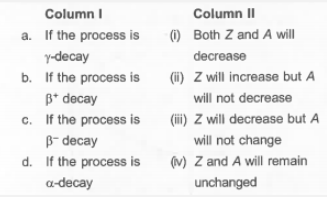Staements I: .zXA undergoes 2α-decays, 2β-decays (negative β) and 2γ-decays. As a result, the daughter product is .z.−2XA−8.
Staements II: In α-decay, the mass number decreases by 4 unit and atomic number decreases by 2 unit. In β-decay (negative β), the mass number remains unchanged and atomic number increases by 1 unit. In γ-decay, mass number and atomic number remain unchanged.
Statement-1 is true, Statement-2: is true, Statement-2 is a correct explanation for Statement-1.
Statement-1 is true, Statement-2: is true, Statement-2 is NOT a correct explanation for Statement-1.
Statement-1 is true but statement-2 is false
Statement-1 is false, Statement-2 is true
The correct Answer is:A
To solve the problem, we need to analyze the decay processes step by step based on the information provided in the statements.
1. Initial Nucleus: We start with a nucleus represented as zXA, where A is the mass number and z is the atomic number.
2. Alpha Decay:
- In alpha decay, the mass number decreases by 4 and the atomic number decreases by 2.
- After 2 alpha decays:
- Mass number: A−4−4=A−8
- Atomic number: z−2−2=z−4
- Thus, after 2 alpha decays, the nucleus becomes z−4XA−8.
3. Beta Decay:
- In negative beta decay, the mass number remains unchanged, but the atomic number increases by 1.
- After 2 beta decays:
- Mass number: A−8 (remains the same)
- Atomic number: z−4+2=z−2
- Thus, after 2 beta decays, the nucleus becomes z−2XA−8.
4. Gamma Decay:
- In gamma decay, both the mass number and atomic number remain unchanged.
- Therefore, after 2 gamma decays, the nucleus remains z−2XA−8.
5. Final Daughter Product: After all the decays, the final daughter product is z−2XA−8.
Conclusion:
- Statement I is true as the daughter product is indeed z−2XA−8.
- Statement II is also true as it accurately describes the changes in mass number and atomic number during alpha, beta, and gamma decays.
Final Answer:
Both statements are true, and Statement II provides the correct explanation for Statement I.
- In alpha decay, the mass number decreases by 4 and the atomic number decreases by 2.
- After 2 alpha decays:
- Mass number: A−4−4=A−8
- Atomic number: z−2−2=z−4
- Thus, after 2 alpha decays, the nucleus becomes z−4XA−8.
- In negative beta decay, the mass number remains unchanged, but the atomic number increases by 1.
- After 2 beta decays:
- Mass number: A−8 (remains the same)
- Atomic number: z−4+2=z−2
- Thus, after 2 beta decays, the nucleus becomes z−2XA−8.
- In gamma decay, both the mass number and atomic number remain unchanged.
- Therefore, after 2 gamma decays, the nucleus remains z−2XA−8.
- Statement I is true as the daughter product is indeed z−2XA−8.
- Statement II is also true as it accurately describes the changes in mass number and atomic number during alpha, beta, and gamma decays.
Both statements are true, and Statement II provides the correct explanation for Statement I.
Topper's Solved these Questions
Similar Questions
Staements I: .zXA undergoes 2α-decays, 2β-decays (negative β) and 2γ-decays. As a result, the daughter product is .z.−2XA−8.
Staements II: In α-decay, the mass number decreases by 4 unit and atomic number decreases by 2 unit. In β-decay (negative β), the mass number remains unchanged and atomic number increases by 1 unit. In γ-decay, mass number and atomic number remain unchanged.
View SolutionStaements I: .zX4 undergoes 2α-decays, 2β-decays (negative β) and 2γ-decays. As a result, the daughter product is .z.−2XA−B.
Staements II: In α-decay, the mass number decreases by 4 unit and atomic number decreases by 2 unit. In β-decay (negative β), the mass number remains unchanged and atomic number increases by 1 unit. In γ-decay, mass number and atomic number remain unchanged.
View SolutionStaements I: .zX4 undergoes 2α-decays, 2β-decays (negative β) and 2γ-decays. As a result, the daughter product is _(z−2)XA−8.
Staements II: In β-decay, the mass number decreases by 4 unit and atomic number decreases by 2 unit. In β-decay (negative β), the mass number remains unchanged and atomic number increases by 1 unit. In γ-decay, mass number and atomic number remain unchanged.
View SolutionA nucleus undertgoes β-decay. How does its (i) mass number (ii) atomic number change ?
View SolutionThe emission of an α− particle reduces the mass of nuclei by 4 units and increases its atomic number by 2.
View SolutionAssertion : After emission of one α-particle and two β-particles, atomic number remains unchanged.
Reason : Mass number changes by four.
View SolutionAn elementX decays , first by positron emission and then two α-particles are emitted in successive radiactive decay. If the product nucleus has a mass number 229 and atomic number 89, the mass number and atomic number of element X are.
View SolutionWrite the complete symbols for the nuclei with
(i) atomic number 17 and mass number 35
(ii) atomic number 8 and mass number 16
(iii) atomic number 26 and mass number 55
(iv) atomic number 2 and mass number 4.
View SolutionAssetion In α-decay atomic number of daughter nucleus reduces by 2 units from the parent nucleus.
Reason An α particle carries four units of mass.
View SolutionMatch the column in radioactive decay process of nucleus with atomic number Z and mass number A.

View Solution
